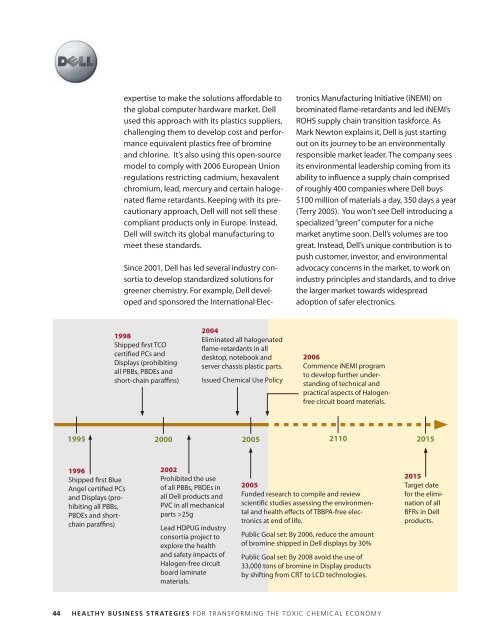Healthy Business Strategies - Clean Production Action
Healthy Business Strategies - Clean Production Action
Healthy Business Strategies - Clean Production Action
Create successful ePaper yourself
Turn your PDF publications into a flip-book with our unique Google optimized e-Paper software.
expertise to make the solutions affordable to<br />
the global computer hardware market. Dell<br />
used this approach with its plastics suppliers,<br />
challenging them to develop cost and performance<br />
equivalent plastics free of bromine<br />
and chlorine. It’s also using this open-source<br />
model to comply with 2006 European union<br />
regulations restricting cadmium, hexavalent<br />
chromium, lead, mercury and certain halogenated<br />
flame retardants. Keeping with its precautionary<br />
approach, Dell will not sell these<br />
compliant products only in Europe. Instead,<br />
Dell will switch its global manufacturing to<br />
meet these standards.<br />
Since 2001, Dell has led several industry consortia<br />
to develop standardized solutions for<br />
greener chemistry. For example, Dell developed<br />
and sponsored the International Elec-<br />
tronics Manufacturing Initiative (iNEMI) on<br />
brominated flame-retardants and led iNEMI’s<br />
ROHS supply chain transition taskforce. As<br />
Mark Newton explains it, Dell is just starting<br />
out on its journey to be an environmentally<br />
responsible market leader. The company sees<br />
its environmental leadership coming from its<br />
ability to influence a supply chain comprised<br />
of roughly 400 companies where Dell buys<br />
$100 million of materials a day, 350 days a year<br />
(Terry 2005). you won’t see Dell introducing a<br />
specialized “green” computer for a niche<br />
market anytime soon. Dell’s volumes are too<br />
great. Instead, Dell’s unique contribution is to<br />
push customer, investor, and environmental<br />
advocacy concerns in the market, to work on<br />
industry principles and standards, and to drive<br />
the larger market towards widespread<br />
adoption of safer electronics.<br />
1995 2000 2005 2110 2015<br />
1996<br />
Shipped first Blue<br />
Angel certified PCs<br />
and Displays (prohibiting<br />
all PBBs,<br />
PBDEs and shortchain<br />
paraffins)<br />
1998<br />
Shipped first TCO<br />
certified PCs and<br />
Displays (prohibiting<br />
all PBBs, PBDEs and<br />
short-chain paraffins)<br />
2002<br />
Prohibited the use<br />
of all PBBs, PBDEs in<br />
all Dell products and<br />
PvC in all mechanical<br />
parts >25g<br />
Lead HDPuG industry<br />
consortia project to<br />
explore the health<br />
and safety impacts of<br />
Halogen-free circuit<br />
board laminate<br />
materials.<br />
2004<br />
Eliminated all halogenated<br />
flame-retardants in all<br />
desktop, notebook and<br />
server chassis plastic parts.<br />
Issued Chemical use Policy<br />
2006<br />
Commence iNEMI program<br />
to develop further understanding<br />
of technical and<br />
practical aspects of Halogenfree<br />
circuit board materials.<br />
2005<br />
Funded research to compile and review<br />
scientific studies assessing the environmental<br />
and health effects of TBBPA-free electronics<br />
at end of life.<br />
Public Goal set: By 2006, reduce the amount<br />
of bromine shipped in Dell displays by 30%<br />
Public Goal set: By 2008 avoid the use of<br />
33,000 tons of bromine in Display products<br />
by shifting from CRT to LCD technologies.<br />
healthy business strategies for transforming the toxic chemical economy<br />
2015<br />
Target date<br />
for the elimination<br />
of all<br />
BFRs in Dell<br />
products.


